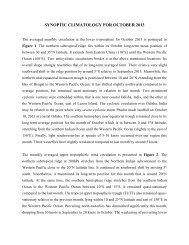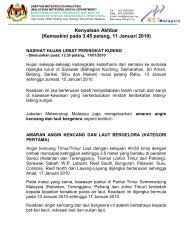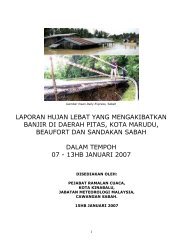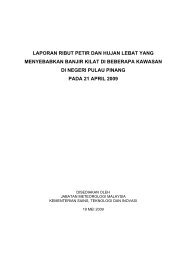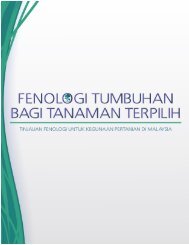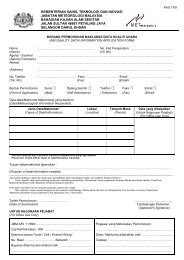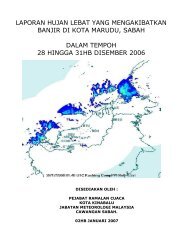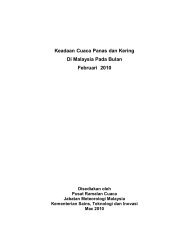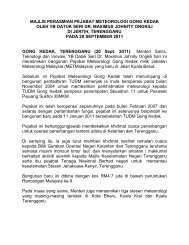RAINFALL INDEX
RAINFALL INDEX
RAINFALL INDEX
Create successful ePaper yourself
Turn your PDF publications into a flip-book with our unique Google optimized e-Paper software.
<strong>RAINFALL</strong> <strong>INDEX</strong><br />
vs<br />
SOUTHERN OSCILLATION <strong>INDEX</strong> (SOI)<br />
(over various region in Malaysia)<br />
SOI (Southern Oscillation Index)<br />
- Is calculated from the monthly or seasonal fluctuations in the air pressure<br />
difference between Tahiti and Darwin.<br />
Mathematical Method:<br />
There are few different methods of how to calculate the SOI. The method that is<br />
used here, Troup SOI which is the standardised anomaly of the Mean Sea Level<br />
Pressure difference between Tahiti and Darwin. It is calculated as follows:<br />
[ Pdiff – Pdiffav ]<br />
SOI = 10 -----------------------<br />
SD (Pdiff)<br />
Where,<br />
Pdiff = (average Tahiti MSLP for the month) – (average Darwin MSLP for the month)<br />
Pdiffav = long term average of Pdiff for the month in question<br />
SD (Pdiff) = long term standard deviation of Pdiff for the month in question
Rainfall Index<br />
The index is calculated by the following formula:<br />
Rainfall Index (year x) = monthly rainfall (year x) - normal mean<br />
--------------------<br />
SD<br />
The Analysis<br />
Sustained negative values of the SOI often indicate El Niño episodes. These<br />
negative values are usually accompanied by sustained warming of the central and<br />
eastern tropical Pacific Ocean, a decrease in the strength of the Pacific Trade Winds,<br />
and a reduction in rainfall. The most recent strong El Niño was in 1997/98.<br />
Positive values of the SOI often indicate La Niña episodes. Waters in the central<br />
and eastern tropical Pacific Ocean become cooler and the pacific trade wind was<br />
stronger during this time. Together these give an increased probability that most regions<br />
in Malaysia will be wetter than normal. The most recent strong La Niña was in<br />
1999/2001. A moderate La Niña developed slowly during 2007.<br />
Following are graphs of Rainfall Index vs SOI which have been plotted for<br />
various regions in Malaysia:<br />
a) Peninsular Malaysia<br />
Northwestern Region<br />
Central and Southern Region<br />
Eastern Region
) Sarawak<br />
Eastern Division<br />
Western Division<br />
c) Sabah<br />
Eastern Residency<br />
Western Residency



